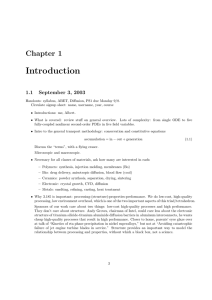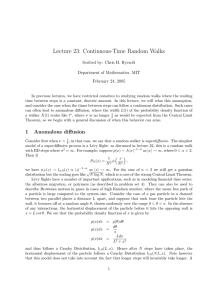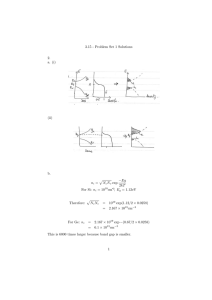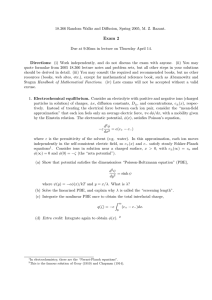Lecture 24: Non-Markovian Diffusion Equations Department of Mathematics, MIT
advertisement
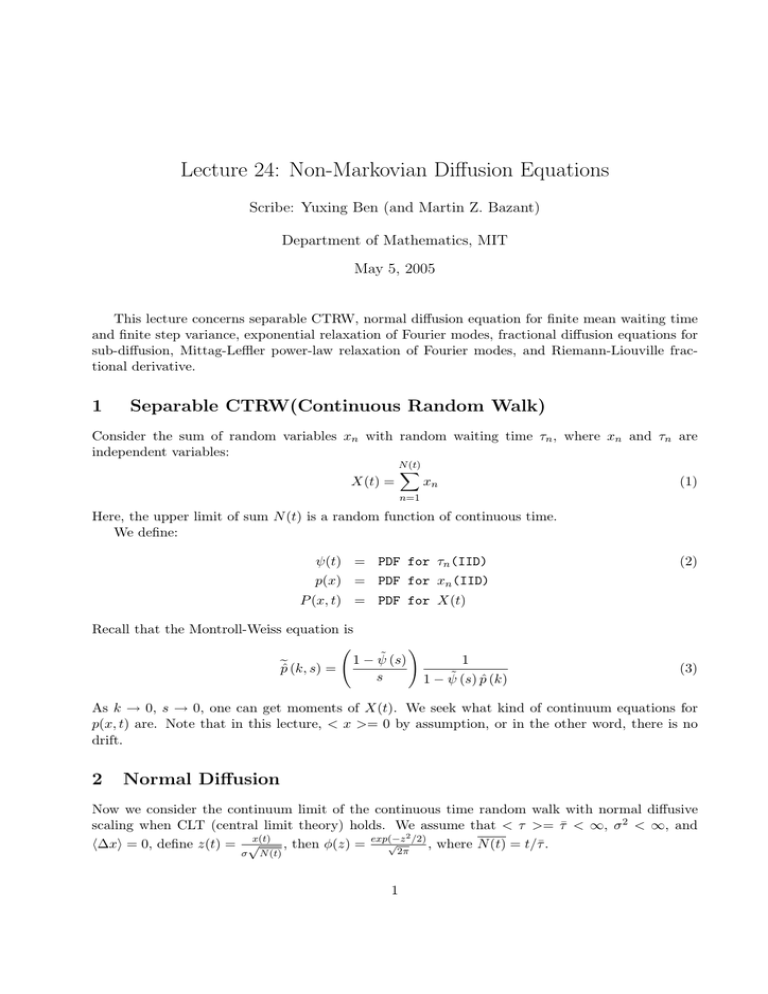
Lecture 24: Non-Markovian Diffusion Equations Scribe: Yuxing Ben (and Martin Z. Bazant) Department of Mathematics, MIT May 5, 2005 This lecture concerns separable CTRW, normal diffusion equation for finite mean waiting time and finite step variance, exponential relaxation of Fourier modes, fractional diffusion equations for sub-diffusion, Mittag-Leffler power-law relaxation of Fourier modes, and Riemann-Liouville frac­ tional derivative. 1 Separable CTRW(Continuous Random Walk) Consider the sum of random variables xn with random waiting time τn , where xn and τn are independent variables: N (t) � X(t) = xn (1) n=1 Here, the upper limit of sum N (t) is a random function of continuous time. We define: ψ(t) = PDF for τn (IID) (2) p(x) = PDF for xn (IID) P (x, t) = PDF for X(t) Recall that the Montroll-Weiss equation is � � ˜ (s) − ψ 1 1 � p̂ (k, s) = s 1 − ψ̃ (s) p̂ (k) (3) As k → 0, s → 0, one can get moments of X(t). We seek what kind of continuum equations for p(x, t) are. Note that in this lecture, < x >= 0 by assumption, or in the other word, there is no drift. 2 Normal Diffusion Now we consider the continuum limit of the continuous time random walk with normal diffusive scaling when CLT (central limit theory) holds. We assume that < τ >= τ¯ < ∞, σ 2 < ∞, and 2 /2) x(t) √ , where N (t) = t/τ̄ . �Δx� = 0, define z(t) = √ , then φ(z) = exp(−z 2π σ N (t) 1 M. Z. Bazant – 18.366 Random Walks and Diffusion – Lecture 24 2 The walker is assumed to have a finite mean waiting time, so the waiting-time distribution satisfies � � ψ (t) = o t−2 , and thus its Laplace transform will have a small s-expansion governed by ψ̃ (s) ∼ 1 − τ̄ s, s → 0, and σ2 k2 , k → 0. 2 Substituting into Eq.(3), we have the long-time limit pˆ (k) ∼ 1 − � p̂ (k, s) ∼ τ̄ τ¯s + σ 2 k2 2 + ··· ∼ 1 , s + Dk 2 where σ2 . 2τ̄ �∞ The definition of Laplace transform is � p̂ (k, s) = 0 e−st p̂(k, t)dt. Inverting Laplace Transform leads to 2 p̂(k, t) ∼ e−Dk t = e−t/t(k) D= 1 where t(k) = Dk 2 , and is the exponential relaxation time for Fourier mode k. Note that large k decays fast. As a result, p (x, t) approaches the solution of the normal diffusion equation, 2 e−x /4Dt p (x, t) ∼ √ 4πDt �√ � as t → ∞ and x = O t . (This is again the central limit theorem for CTRW.) Since the equation is linear, the same continuum limit holds for any initial condition of the CTRW. Note X(t) X X(t) =� = z(t) = √ 2 2Dt σ t/τ̄ N (t) To compare p(k, ˆ t) and P (x, t): 1)p(k, ˆ t) satisfies ODE p̂ ∂p̂ with initial condition p̂(k, 0) = 1; =− ∂t t(k) 2)P (x, t) satisfies PDE 3 ∂P ∂2P = D 2 , P (x, 0) = δ(x). ∂t ∂x Super Diffusion Assume τ̄ is finite < ∞, but σ 2 = ∞ and symmetric p(−x) = p(x) (This is Levy flight). For α example: p(ˆk) = e−a|k| (0 < α < 2), p(x) = �α,a (x). Consider ψ̃(s) ∼ 1 − τ̄ s, s → 0 M. Z. Bazant – 18.366 Random Walks and Diffusion – Lecture 24 3 p(k) ˆ ∼ 1 − B |k|α , k → 0 Using Eq.(3), we obtain τ̄ τ¯s + B|k|α + · · · � p̂ (k, s) ∼ Invert Laplace Transform B αt p̂(k, t) ∼ e− τ¯ |k| = e−t/t(k) To summarize, we still have exponential relaxation of Fourier modes in time, but now τ̄ , α < 2. B |k |α t(k) = So large k (or small wavelength) features decay more slowly compared to normal diffusion, but small k decay faster. Still p̂ ∂p̂ =− ODE ∂t t(k) B ∂p̂ = − |k |α p̂ ∂t τ̄ 1 α Let κ(t) = k( Bt τ ) ↔ z = x 1 ( Bt )α τ ¯ α , p̂ ∼ e−|k(t)| , then τ̄ 1 P (x, t) ∼ ( ) α �α,1 Bt � � � τ̄ � α1 x 1 B tα with scales like tν , where ν = 1/α > 12 , the supper diffusion. Note P (x, t) satisfies a fractional diffusion equation ∂P B = ( |�|α P ) ∂t τ̄ where �α is the Riese fractional derivative which can be defined by: α f (k) = −|k|α fˆ(k) � |�| �� ∞ � � ∞ α ikx α −ikx� � � dk |�| f (x) = e (−|k | ) e f (x )dx 2π −∞| −∞ � � dk � = (f ∗ δα )(x) = f (x� )eik(x−x ) |k|α dx� 2π where � δα = − � ∞ −∞ eikx |k|α dk 2π dk When α = 0, this is δ(x) = eikx 2π and δ(x) is localized. This function δα (x) is not localized in x. dn f dn α n α If α is integer, |k | = k , δn (x) = dx n δ(x), then |�| f → dxn . Hence, boundary conditions for supper diffusion are subtle (fat tails in steps). M. Z. Bazant – 18.366 Random Walks and Diffusion – Lecture 24 4 4 Subdiffusion 4.1 Mittag-Leffler Power-Law Decay of Fourier Modes Consider symmetric (p(x) = p(−x)), anomalous subdiffusion with an infinite the mean waiting time (�τ � = ∞) but finite σ 2 for which the waiting-time distribution satisfies ψ (t) ∼ � τ �1+γ 0 τ , and N (t) ∼ tγ where 0 < γ < 1 or equivalently ψ̃ has the following small-s expansion of its Laplace transform , ψ̃ (s) ∼ 1 − (τ0 s)γ , s → 0. As k → 0, σ2 k2 2 p̂(k) ∼ 1 − Thus, we have � � p̂ (k, s) ∼ (τ0 s)γ s � 1 (τ0 s)γ + σ 2 k2 2 + ··· . (4) The factor in front of (4) is not a constant, and in fact is a singularity, as γ − 1 < 0. This crucial term, which is negligible in the case of normal diffusion, represents walks that have not moved yet. We can rewrite (4) as � � 1 1 � , (5) p̂ (k, s) ∼ γ ¯ s 1 + (t(k)s) where σ2 k2 t¯(k)−γ = τ0−γ . 2 Or, ¯ = τ0 t(k) k 2/γ � 2 σ2 �1 γ ∝ 1 k 2/γ Inverting Laplace transform gives p̂(k, t) = Eγ (−(t/E(k))γ ) � zn where Eγ (z) is Mittg-Leffler function, and Eγ (z) = ∞ n=0 Γ(1+γn) . Note E1 (z) = ∞ � n=0 ∞ � zn zn = = ez , Γ(1 + n) n! n=0 So we recover p̂(k, t) = e−t/t̄(k) for γ = 1. 2 E1/2 (z) = ez erf c(−z), M. Z. Bazant – 18.366 Random Walks and Diffusion – Lecture 24 where erfc (x) is the complementary error function (erf (z) = π2 In this case, � ¯ p̂(k, t) = et/t̄(k) erf c( t/t(k)) �z 0 5 2 e−x dx, erf c(z) = 1 − erf (z)). Asymptotics: ¯ γ) p̂(k, t) = Eγ (−t/t(k) For the non-exponential cases 0 < γ < 1, the asymptotic expansions of the Mittag-Leffler functions are ⎧ � � γ ⎨ exp − (t/t̄(k)) , t → 0 γ �Γ(1+γ) �γ ¯ , Eγ (− (t/t(k)) )∼ t̄(k) 1 ⎩ , t → ∞ t Γ(1−γ) so we have stretched-exponential decay at short times and power-law decay at long times. Now what is the continuum relaxation equation? � ∞ � df df ˜ (s) = sf (s) − f (0) = e−st (t)dt dt dt 0 ∂ p̂˜ ˜ s) − p̂(k, 0) (k, s) = sp̂(k, ∂t At the long time limit in the central region ∂ p̃ˆ (k, s) ∼ ∂t 1 −1 1 + (τ (k)s)−γ ¯ −γ (ts) = − ¯ −γ 1 + (ts) (6) = −t̄(k)−γ s1−γ p̃(k, ˆ s) 2 1−γ σ 2 2 2 P (k, s). Here, t̄(k)−γ = 2τ γ k = Dγ k = −Dγ k 0 Dt 0 For p̂, it satisfies equation ∂p̂ = −Dγ k 2 0 Dt1−γ p̂ ∂t where 0 Dtβ is the Riemann-Lionvill fractional derivative. So p(x, t) satisfies � � ∂p = Dγ 0 Dt1−γ �2 p. ∂t (7) This is a fractional diffusion equation. For subdiffusion, boundary conditions are easy, but initial condition is subtle. Besides,0 Dt1−γ is nonlocal in time, depending on the history.
